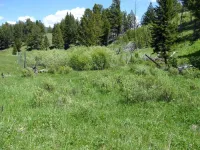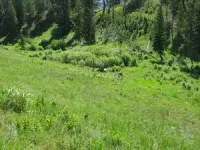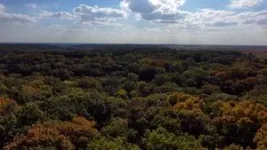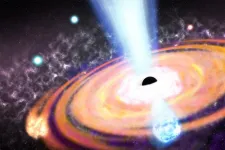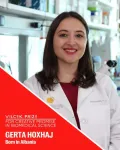(Press-News.org) A Colorado State University experiment spanning more than two decades has found that removal of apex predators from an ecosystem can create lasting changes that are not reversed after they return – at least, not for a very long time.
The study, funded by the National Science Foundation and published in Ecological Monographs, challenges the commonly held belief that the reintroduction of wolves to Yellowstone National Park restored an ecosystem degraded by their absence.
Researchers in CSU’s Warner College of Natural Resources examined the effects of three apex predators – carnivores at the top of the food chain not preyed on by other animals – in Yellowstone. Depleted populations of cougars and grizzly bears naturally recovered about the same time wolves were reintroduced to the park in 1995. The absence of these predators for nearly a century transformed the food web and landscape.
Yellowstone’s northern range shifted from willow and aspen stands along small streams with beaver activity to grasslands due to intensive browsing by elk. The widespread changes stabilized into an alternative ecological state that resisted returning to previous conditions once the carnivores were restored, according to authors of the study, Tom Hobbs and David Cooper.
This designed experiment conducted in Yellowstone is the longest of its kind and adds to evidence supporting the theory that degradation of ecosystems may not be reversed when harmful stressors are mitigated.
"When you disturb ecosystems by changing the makeup of a food web, it can lead to lasting changes that are not quickly fixed,” said Hobbs, lead author and professor emeritus with the Department of Ecosystem Science and Sustainability and the Natural Resource Ecology Laboratory. “We can't rule out the possibility that the ecosystem will be restored over the next 40 years as a result of the return of apex predators. All we can be sure of is what's observable now — the ecosystem has not responded dramatically to the restored food web.”
Though not a quick and easy solution, Hobbs said, restoration of apex predators produces healthier ecosystems in the long run.
"The conservation message is don't lose them in the first place,” Hobbs said. “Keep the food web intact, because there's not a quick fix for losing top predators from ecosystems.”
Can Colorado learn from Yellowstone?
Colorado Parks and Wildlife introduced five wolves to the state Dec. 18 with plans to bring in more in coming years. Wolves were eradicated in the state by the mid-1940s, but Colorado voters approved their restoration by a narrow margin in 2020.
This study may hold lessons about how restoring apex predators affects the ecosystem, but Hobbs said that the environmental degradation resulting from Yellowstone’s policy not to cull elk was never replicated in Colorado.
"Unlike Yellowstone, Colorado's landscapes have not experienced widespread excessive grazing or browsing from elk,” Hobbs said. “The state has done a good job of managing elk populations using hunting."
Hobbs and Cooper said there are many good reasons to restore wolves; just don’t expect them to cause immediate ecosystem improvements.
"Our work supports the fact that wolves are important components of ecosystems,” said Cooper, a research scientist emeritus in the Department of Forest and Rangeland Stewardship. “They will have some ecosystem benefits by reducing some large herbivore populations. Over the next hundred years, they'll have a greater role in regulating some of the ecological processes that we've been studying."
What do willows have to do with wolves?
Wolves and cougars were wiped out in Yellowstone by the early 1920s. Without apex predators or human hunters to control their population, elk fed on the willows along small streams in Yellowstone’s northern range, depleting beavers’ food supply and building materials and causing them to abandon the streams in favor of more suitable areas.
Historically, beavers and willows relied on each other to thrive. Flooding caused by beaver dams created favorable soil moisture conditions for willows, and willows provided food and dam-building materials for beavers. Without beaver-engineered flooding, small streams in the northern range cut deeper into the landscape, disconnecting roots of willows from groundwater. Willows never recovered their former height and density.
Following the reintroduction of wolves to the park in 1995, as cougar and grizzly populations were rebounding on their own, the elk population dropped from both predation and hunting by humans along park borders.
However, overall browsing of woody food sources has not declined proportionally. As the number of elk has decreased, bison herds have increased. Yellowstone’s carnivores typically don’t prey on bison because their large size makes them dangerous.
Long-term experiment
In 2001, CSU ecologists began an experiment to gauge whether the Yellowstone ecosystem would recover due to the restoration of apex predators. They established four study areas in the park’s northern range, fenced off eight plots to prevent browsing and constructed simulated beaver dams in some fenced and non-fenced plots to raise the water table. They also left control areas unaltered. In 2009, they added 21 more control plots to ensure the results of their experiment were representative of the landscape.
If predators regulated the elk population, preventing them from cutting down willows, the landscape would hypothetically return to its previous state. Instead, the willows remained short on control plots, while the fenced sites with simulated dams showed dramatic recovery.
Willows grew more than three times taller in the fenced, dammed areas than in the control plots, indicating the importance of groundwater access in addition to mitigation of browsing.
By manipulating one factor at a time – browsing and hydrology – at many sites for a long time, the researchers were able to show that carnivores were not causing landscape restoration.
"We learned from the science that it was way more complicated,” Cooper said.
“Our result is well supported by ecological theory and empirical results from all over the world,” Hobbs added. “Disturbing food webs can cause persistent changes in ecosystems.”
Research in Yellowstone is common, but this study was rare in its manipulation of the landscape and its duration. Hobbs and Cooper worked closely with park management and biologists, including Yellowstone National Park Senior Wildlife Biologist Daniel Stahler, to answer questions relevant to the park’s needs and share results to help guide park policy.
"This research contributes greatly to our understanding of Yellowstone by teasing out the degree to which complex links in a food web affect ecosystems under native species recovery,” Stahler said. “Importantly, it is among few published studies to date on the Yellowstone ecosystem that highlight that not just wolves, but multiple predator species together have contributed to changes in elk abundance. This point has ramifications for how we evaluate how complex ecosystems respond to carnivore presence and absence.”
He continued, “This long-term research conducted by the CSU team also highlights the value of national parks in helping us understand ecological processes, in order to better protect ecosystems. We should not only cherish our national parks because they protect, preserve and allow people to enjoy nature, but because they provide a place where well-designed science can elevate our understanding of its complexity."
END
Apex predators not a quick fix for restoring ecosystems, 20-year CSU study finds
2024-02-06
ELSE PRESS RELEASES FROM THIS DATE:
Do digital technologies offer a better way to loan people money?
2024-02-06
A new paper in the Quarterly Journal of Economics, published by Oxford University Press, finds that a new form of digital technology—essentially preventing people from using an asset for which they have a loan if they don’t make payments, rather than repossessing the asset itself—may be a better way for lenders to secure loans, particularly for loan recipients in developing countries.
Using collateral to secure debt helps overcome economic frictions, lowering the cost of providing credit. More than 80% of total household debt in the United States is secured by ...
Fiona M. Watt receives the 2024 ISSCR Achievement Award for her seminal work with skin stem cells
2024-02-06
Evanston, IL—The International Society for Stem Cell Research (ISSCR) will award its 2024 ISSCR Achievement Award to Fiona M. Watt, D.Phil., F.R.S., F.Med.Sci., EMBO Director and leader of a research group at EMBL - Heidelberg, Germany. The award recognizes the transformative body of work of an investigator that has had a major impact on the field of stem cell research or regenerative medicine. Dr. Watt will present her research during Plenary VII on 13 July at the ISSCR 2024 Annual Meeting in Hamburg, Germany. ISSCR 2024 is the world’s leading gathering of the brightest minds in stem cell research and cell and regenerative medicine.
“Fiona is a giant in stem cell ...
Jun Wu receives the 2024 ISSCR Outstanding Young Investigator Award for his innovative work on stem cell-based embryo and chimera models
2024-02-06
Evanston, IL—The International Society for Stem Cell Research (ISSCR) is honoring Jun Wu, Ph.D. with the 2024 ISSCR Outstanding Young Investigator Award. Dr. Wu is an associate professor in the Department of Molecular Biology at the University of Texas Southwestern Medical Center, U.S.A. and a New York Stem Cell Foundation–Robertson Investigator.
The award recognizes the exceptional achievements of an investigator in the early part of his or her independent career in stem cell research. Dr. Wu will present his work during Plenary II, New Technologies to Engineer and Phenotype Stem Cell Systems, on 10 July during the ISSCR 2024 Annual Meeting taking place in Hamburg, Germany. ...
Sergiu P. Paşca receives the 2024 ISSCR Momentum Award for his pioneering work in neurodevelopment and disease
2024-02-06
Evanston, IL— The International Society for Stem Cell Research (ISSCR) will present this year’s ISSCR Momentum Award to Sergiu P. Paşca, M.D., Kenneth T. Norris, Jr. Professor and the Uytengsu Director of Stanford Brain Organogenesis, Stanford University, U.S.A. The award recognizes the exceptional achievements of a mid-career investigator whose innovative research has established a major area of stem cell-related research with a strong trajectory for future success.
Dr. Paşca will present his research during Plenary VII on 13 July 2024 during the ISSCR 2024 Annual Meeting in Hamburg, Germany. ISSCR 2024 is the world’s leading ...
Understanding neurodiversity across the UK population - study
2024-02-06
A new study has provided insight into how experiences and features of neurodiversity vary amongst adults in the UK.
There is variation in people’s attributes and experiences across all populations. Neurodivergent people, such as people with a diagnosis of ADHD, dyslexia, dyspraxia, or autism, may experience the world in distinctive ways. But, we are only beginning to appreciate how traits and experiences associated with neurodivergence differ across the whole population.
Now, new research from the University of Birmingham has provided a more detailed picture of what neurodiversity looks like amongst adults in the UK.
The research is published in JCPP Advances.
Ian Apperly, ...
A new origin story for deadly Seattle fault
2024-02-06
American Geophysical Union
6 February 2024
AGU Release No. 24-04
For Immediate Release
This press release is available online at: https://news.agu.org/press-release/seattle-fault-may-have-origins-in-an-ancient-tear-in-the-continent
Seattle fault may have origins in an ancient tear in the continent
Magnetic data suggest the hazardous Seattle fault zone developed as the edge of the continent tore itself in two more than 50 million years ago, providing a possible new origin story for the fault
AGU ...
Which came first: Black holes or galaxies?
2024-02-06
Black holes not only existed at the dawn of time, they birthed new stars and supercharged galaxy formation, a new analysis of James Webb Space Telescope data suggests.
The insights upend theories of how black holes shape the cosmos, challenging classical understanding that they formed after the first stars and galaxies emerged. Instead, black holes might have dramatically accelerated the birth of new stars during the first 50 million years of the universe, a fleeting period within its 13.8 billion—year history.
"We know these monster black holes ...
Wang studying learning coordination for Multi-Autonomous Multi-Human (MAMH) agent systems with guaranteed safety
2024-02-06
Xuan Wang, Assistant Professor, Electrical and Computer Engineering, is designing a framework for Multi-Autonomous Multi-Human (MAMH) systems.
The operation of many real-world systems involves the co-existence of human and autonomous agents. Inadequate coordination among these agents can lead to significant performance degradation or safety risks.
In this project, Wang aims to develop a novel framework for Multi-Autonomous Multi-Human coordination, which could enhance algorithmic scalability and ...
Doctors have more difficulty diagnosing disease when looking at images of darker skin
2024-02-06
CAMBRIDGE, MA -- When diagnosing skin diseases based solely on images of a patient’s skin, doctors do not perform as well when the patient has darker skin, according to a new study from MIT researchers.
The study, which included more than 1,000 dermatologists and general practitioners, found that dermatologists accurately characterized about 38 percent of the images they saw, but only 34 percent of those that showed darker skin. General practitioners, who were less accurate overall, showed a similar decrease in accuracy ...
Vilcek Foundation awards $250,000 to immigrant scientists
2024-02-06
The Vilcek Foundation announces the recipients of the 2024 Vilcek Foundation Prizes in Biomedical Science. Awarded annually since 2006, the prizes recognize outstanding immigrant scientists at the forefront of their fields, and celebrate the importance of immigrant contributions to scientific research and discovery in the United States. In 2024, the foundation awards $250,000 in prizes to Luciano Marraffini (b. Argentina), Gerta Hoxhaj (b. Albania), Tomasz Nowakowski (b. Poland) and Takanori Takebe (b. Japan).
“With the 2024 Vilcek Foundation Prizes in Biomedical Science, we honor scientists who have ...
